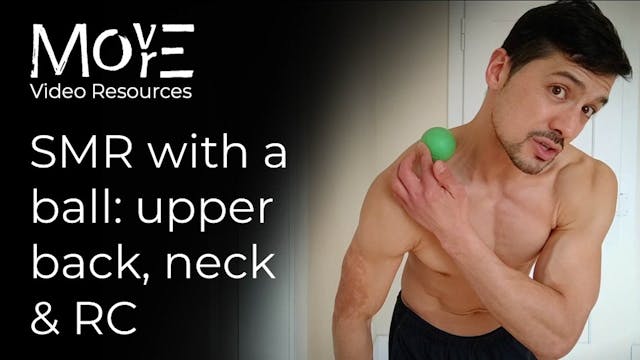IN FOCUS: 'Teacups'
RE-/PREHAB: Shoulders, scap & neck
•
9m 29s
THE WHAT:
Taking an 'In Focus' look at an ancient & fundamental arm-pattern, the 'Teacups'. This movement can be incorporated indefinitely into daily practice, serving as a 'constant' against which to as how you are feeling and moving at this point in time. A as rhythmical, breathing form, it can also serve to calm, focus, and activate autonomic qualities of the parasympathetic nervous system.
On a physiological level, the global extension & flexion serves to mobilise the spine and helps "pump" vital fluids through the body. The shoulders are taken through their full ranges of internal & external rotation, and with it the scapulae express their natural movement though elevation, depression, protraction, retraction, and everything in between.
A recap of the fundamental focus-points shared:
- Soft in knees, soft in hips. Do not "block" yourself.
- Keep weight CENTRED. Avoid leaning forward/backward.
- Coordinate arm-pattern with global ext. flex. of spine.
- Palms face UPWARD at ALL times. Do not spill the tea!
Adjust your arm-pattern to accommodate this constant.
- Keep arm pattern RHYTHMICAL: no one phase of the movement
is faster/slower or bigger/smaller than another.
- MOVE with your BREATHING. Externalise you breaths.
- Use Teacups as a 'constant' to notice day-to-day changes.
PROGRAMMING RECOMMENDAETIONS:
The 'Teacups' are a fundamental global spine/scapular-care & breathing form which also help to rebalance the parasympathetic & sympathetic nervous systems. This means it can be used at any time to "center" oneself, whether as part of a daily morning practice, to commence a dedicated 'Spine & scap' practice, or as part of general preparation/warm-up for a main session of practice.
Essential, it is a form to practiced DAILY. Begin with just 10x repetitions in each direction (medial & lateral), performed with awareness & full intention toward all of the nuances outlined. Revisit the resource after some time for further insights & to maintain curiosity over both the form, and to better answer the question: "how am I feeling today?"
Once strong experience has been developed, work with up to 15x, rhythmical repetitions in each direction.
_____________________________
For programming, guidance, & support for your physical practice:
The 'VRL' subscription platform: https://www.movemorevrl.com/browse
FREE fundamental prehabilitation program: https://www.movemoremp.com/
Online Support (1 to 1 coaching): https://movemoremp.com/onlinesupport/
Elements (standardised programs): https://www.movemoremp.com/elements
[email protected]
Up Next in RE-/PREHAB: Shoulders, scap & neck
-
SMR protocols for habitual kyphosis
THE WHAT:
Fundamental protocols for SMR (self-myofascial release) with focus on areas which, when in a hyper-tonic state, contribute to a 'kyphotic' posture. Commonly caused by work, practice, & life habits, the perspective of 'habitual' kyphosis means that it is your movement HABITS which must b... -
SMR using a tennis/rubber ball
THE WHAT & HOW:
Another fundamental resource for diagnosing, treating, and mitigating hypertonicity in areas of the body which can commonly hold a greater than desirable level of resting tone. Whether from lifestyle or practice habits, if left untreated, what can begin as "superficial-blockages" ... -
SMR for lateral deltoids
THE WHAT & HOW:
Another fundamental resource for diagnosing, treating, and mitigating hypertonicity in areas of the body which can commonly hold a greater than desirable level of resting tone. Whether from lifestyle or practice habits, if left untreated, what can begin as "superficial-blockages" ...



